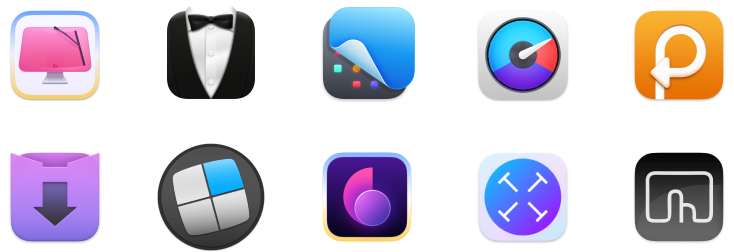How to open, convert, and edit PNG: Beginner's tips
- PNG keeps image quality no matter what.
PNG uses a lossless compression algorithm, meaning your images won’t lose quality even after multiple edits or saves — unlike JPEG. - To open a PNG file, double-click it.
It should open with Preview, a built-in Mac app. Alternatively, right-click the image > Open with > Preview. - To open a PNG in a browser, drag and drop the image there.
It should open in a new tab. All major web browsers support this feature. - Ideal for screenshots, logos, and design.
PNG handles text, fonts, lines, and transparency exceptionally well, making it the perfect format for screenshots, logos, and interface graphics. It supports full transparency, ensuring overlays and web graphics display cleanly. - Easily edit PNGs on Mac.
For more flexibility, use CleanShot X to take and store high-quality PNG screenshots, TouchRetouch to edit, Permute to convert formats safely, and Squash to compress PNGs effectively. These apps are all part of Setapp, a curated suite of 250+ premium Mac and iOS apps. Try them all free for 7 days.
PNG is not just an abbreviation you see on your screenshots, it’s a file format that guarantees your images don’t lose their quality, no matter how many times you edit and re-save them! In this tutorial, I answer the question “What is a PNG file and why should you use it on Mac?” as well as walk you through the easiest ways to open, edit, and convert PNGs.
What is a PNG file?
PNG or Portable Network Graphics (you don’t have to remember that, pinky promise) is a high-quality graphic file format that was created to replace GIF. Unlike the GIF format, PNG doesn’t support animation; however, it is one of the best uncompressed image file formats. Here’s why you should use PNG:
- Lossless compression algorithm. Unlike other formats, a PNG file won’t lose quality each time you reopen and save it. This is called lossless compression — one of the key reasons why PNG is superior to its popular alternative JPEG.
- Best choice for screenshots. Because there’s no quality loss, PNG can handle high-contrast graphics better than JPG. It means it’s best to save images that have text and lines in them — aka screenshots — using PNG format. Particularly if you need to edit your screenshots and re-save them, PNG will help maintain the quality.
- Great for logos, thanks to transparency support. PNG is also great because of its transparent pixels, which make it possible to overlay images. For example, if you need to place a logo over some website content, you’ll have to use PNG with a transparent background. Yes, these days, transparency isn't unique to PNG. Formats like WebP, SVG, HEIF, and AVIF also support transparent backgrounds. However, many people still prefer PNG for web design, graphic design, or web development. Why? Because it simply works. It's reliable, with full support across virtually all tools and platforms, including image viewers and major photo editors from Adobe Photoshop to Canva and Figma. PNG's transparency previews are reliable, file metadata and EXIF are straightforward, and uploads typically work without any issues. (BTW, at the end of this article, you’ll find a comparison table of image file types that support transparency.)
| I want to… | How to do it |
| Open a PNG file | Double-click the PNG or right-click the image > Open with > Preview. |
| Open PNG in a web browser | Drag and drop a PNG image onto your browser, and it will open in a new tab. |
| To save storage space from PNG | Use CleanShot X to store PNG screenshots in the app’s storage. |
| Edit and convert PNG files | Use TouchRetouch for comprehensive PNG editing. |
| Convert PNG to JPEG | Use Permute to convert files into different formats. |
| Compress PNG files | Install and open Squash > Drop images in > Compress menu > Format > Set compression level > Export Image As > Choose. |
How to open PNG files
The native utility to open PNG files on your Mac is Preview. On most Macs, it’s set as a default program for opening images, so you can open your PNG simply by double-clicking it. Alternatively, you can right-click the image > Open with > Preview.

If you don’t want to download a PNG file to your Mac — PNG files are larger than JPEG, which is often the main reason people don’t want to use them — you can view PNG files in your browser. Most web browsers, including Chrome and Safari, have PNG support and can natively open such images in a new tab.
You can also drag and drop a PNG image onto your browser, and it will open in a new tab. (If you have any issues with that, check out how to fix drag and drop on Mac.)
Unlike macOS native utility, CleanShot X lets you save screenshots to its internal cloud and instantly get a shareable link. You’ll never have to worry about the size of those great-quality high-resolution PNG screenshots!
It makes even more sense to use CleanShot X if you need to edit your screenshots — crop, add annotations, etc. The flow that CleanShot X presents is unbeatable: right after you grab a screenshot, you see an overlay menu that lets you edit the screenshot before saving it. And you’ll want to see all the editing options it provides! Brilliant.
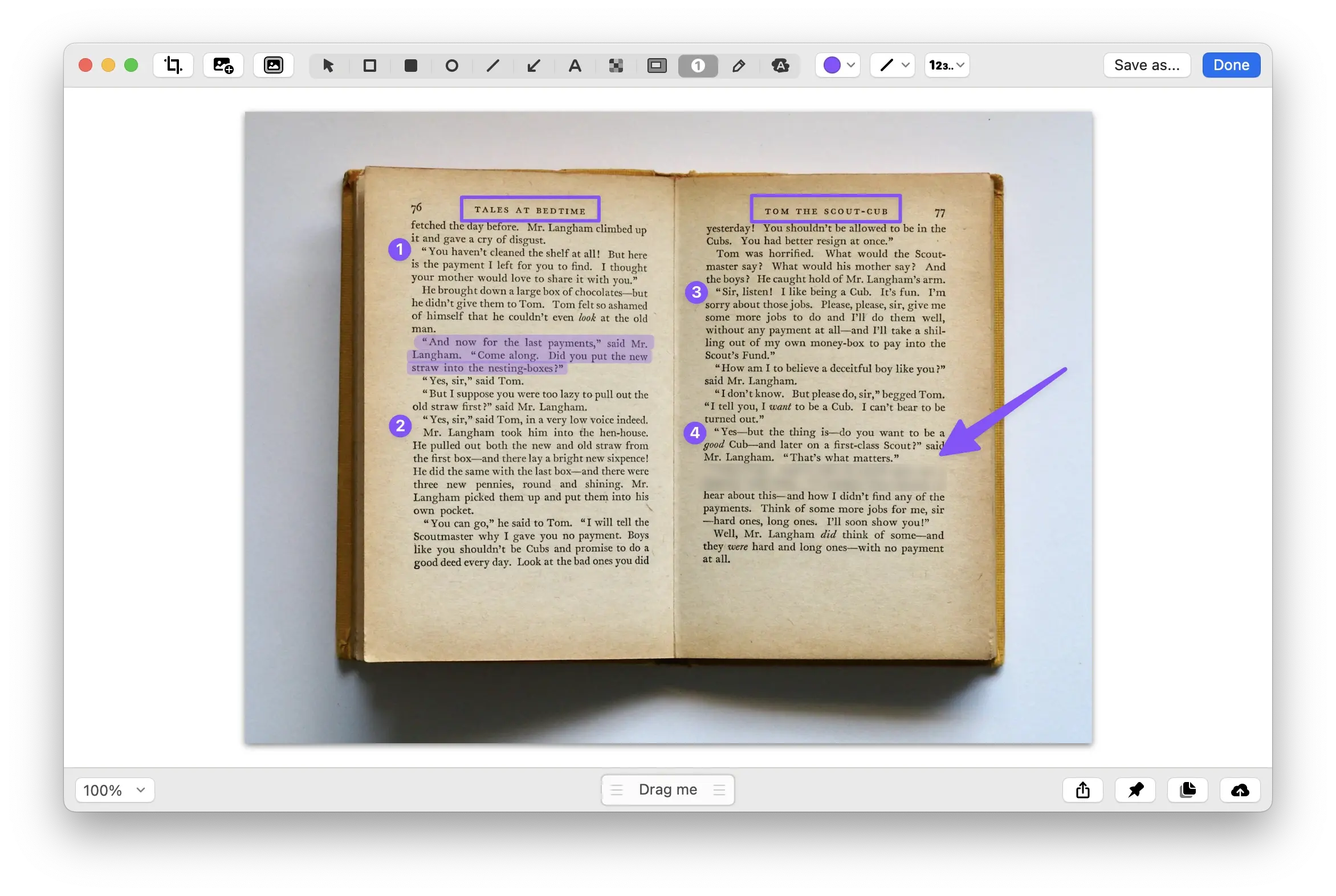
How to edit and convert PNG files
While CleanShot X is ideal for editing PNG screenshots, what about editing other images in PNG format? No worries, there are many tools available.
How to edit PNG files in any way you need
TouchRetouch is one such tool — and a pretty amazing one. Not only does it help with basic editing such as cropping or inserting text, TouchRetouch can remove unwanted objects and lines from your images! All the dots, spots, and defects will be gone in a sec. We recommend this app for professional image retouching as well as preparing logos and other graphics for websites. Impeccable quality guaranteed.
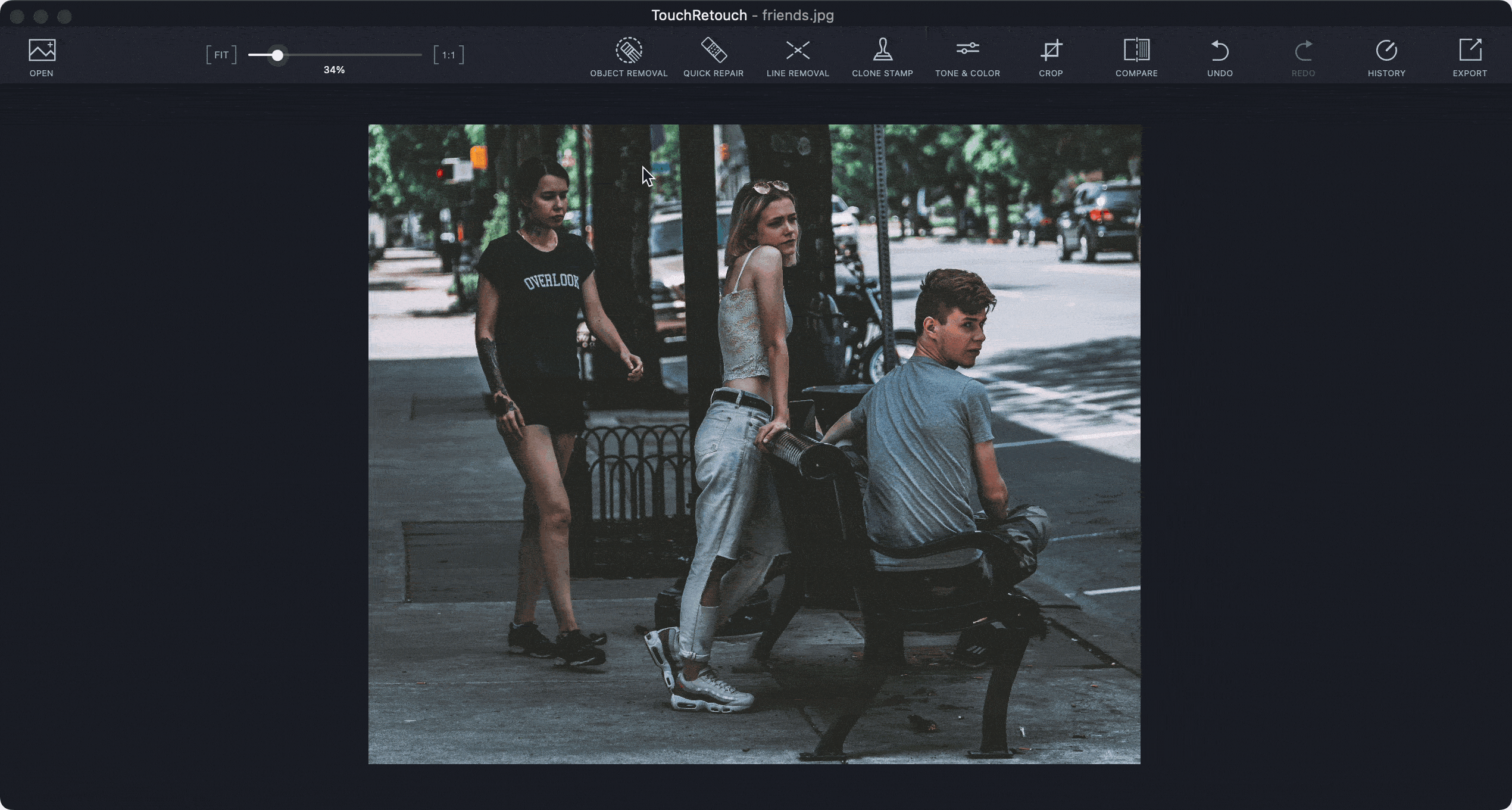
How to convert PNG to JPG (or any other image file format)
Convert PNG to JPEG (or other file types) with Permute. It’s understandable that PNG won’t always serve your purposes and you might need to change the format. If that’s what you want to do, Permute is the most flexible — and the safest! — choice.
Permute is a universal media converter that can convert files to PNG (any file, that is), PNG to JPEG, PNG to PDF, and more. Or, vice versa, convert other images, such as HEIC to PNG. You can also use Permute to convert video and audio files safely on your Mac. Here’s how to use Permute:
- Open Permute.
- Click the plus button and upload your file or use drag and drop.
- Pick the format you want to convert to in the upper-left corner.
- Click the Start button to start the conversion.
- You can also edit PNG — for example, crop it — before converting.
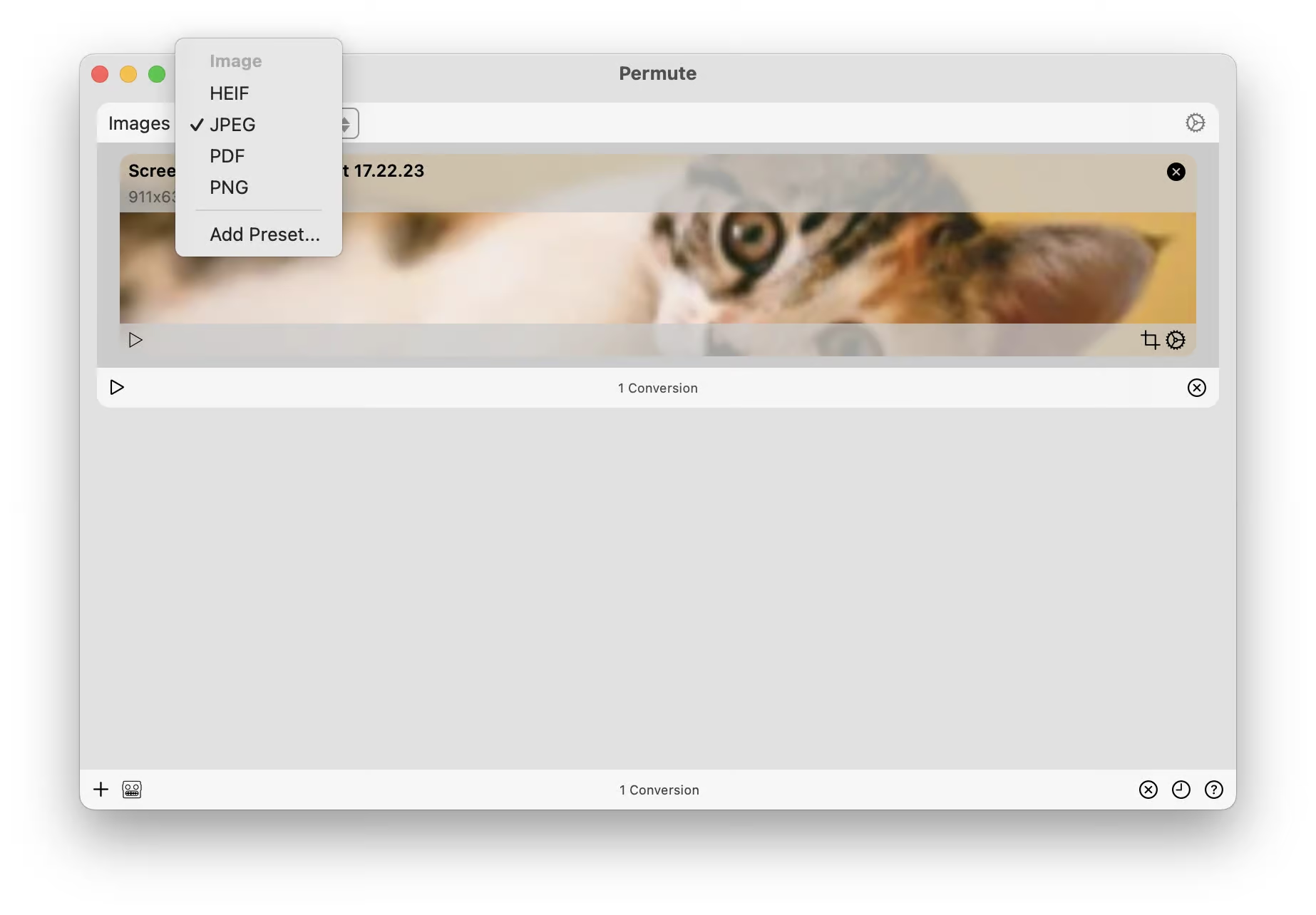
An alternative that you can benefit from without installing any apps is Preview’s native capability to convert PNG to JPEG. Its benefit is that it allows you to convert multiple images at the same time. Here’s how it works:
- Open Preview.
- Hold down Command and choose all the PNGs you want to convert.
- Once the images open in Preview, click on their thumbnails > Export as.
- Click Options > Format > JPEG > Choose.
- Save the converted file to a select location.
TipOne problem with Preview is that you always end up digging around Finder to find where that newly converted file landed. Default Folder X can help — it adds a useful toolbar to your Open and Save dialogs, so you can set up preferred locations and send your files there easily. 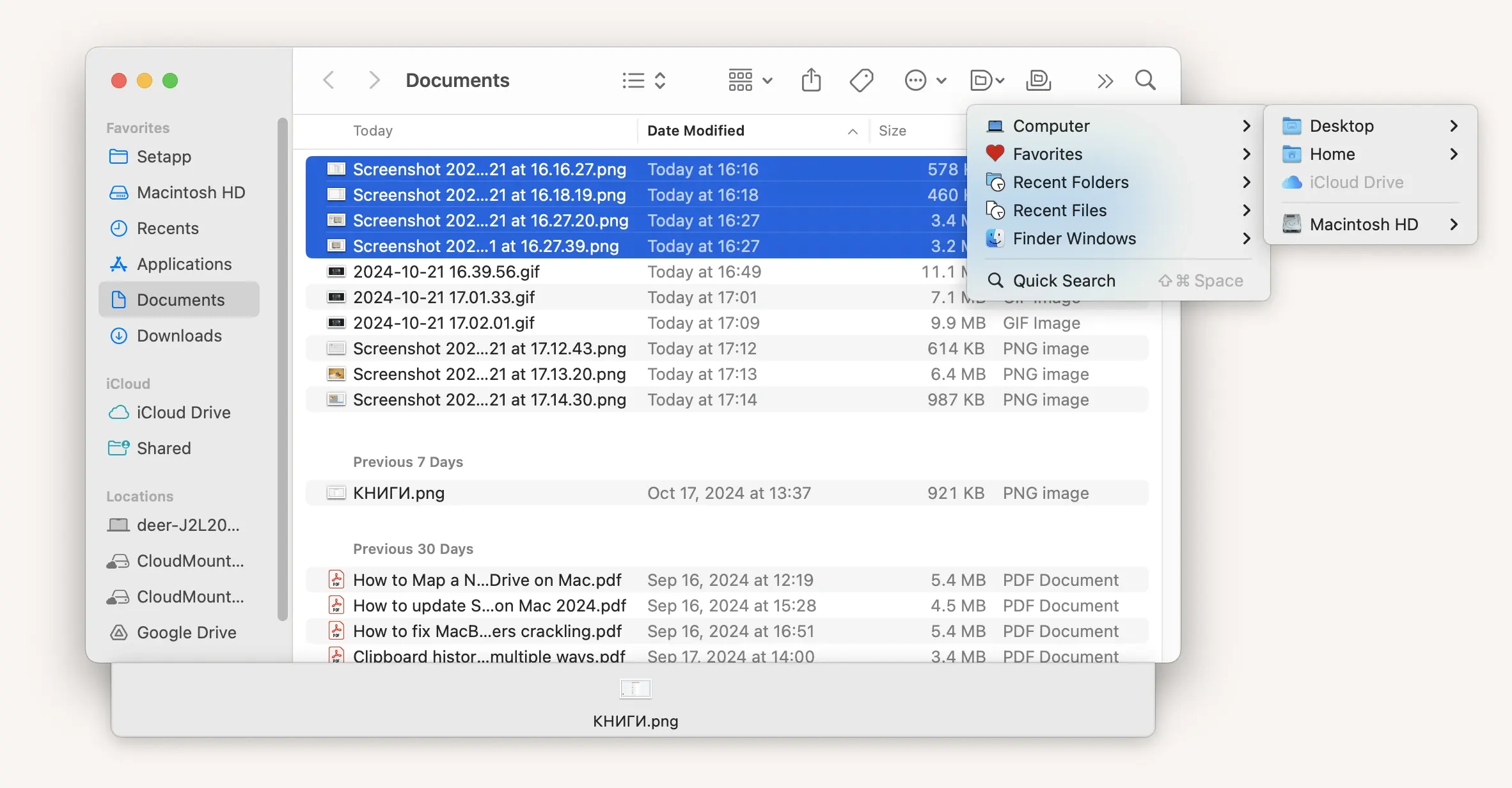 |
How to compress a PNG file
If your converted files turn out too large, I suggest Squash. It’s a win-win solution — an image converter, compressor, and optimizer. Just as Permute, it’s completely safe to use since it handles all your files locally on Mac. Squash supports converting PNG to JPEG, TIFF, and other formats, adjusting file size, removing metadata, and more.
And here’s how you can make those images weigh less:
- Open Squash and drop your original image.
- In the Compress menu, choose image format and set the compression level.
- Click Export Image As > Choose.
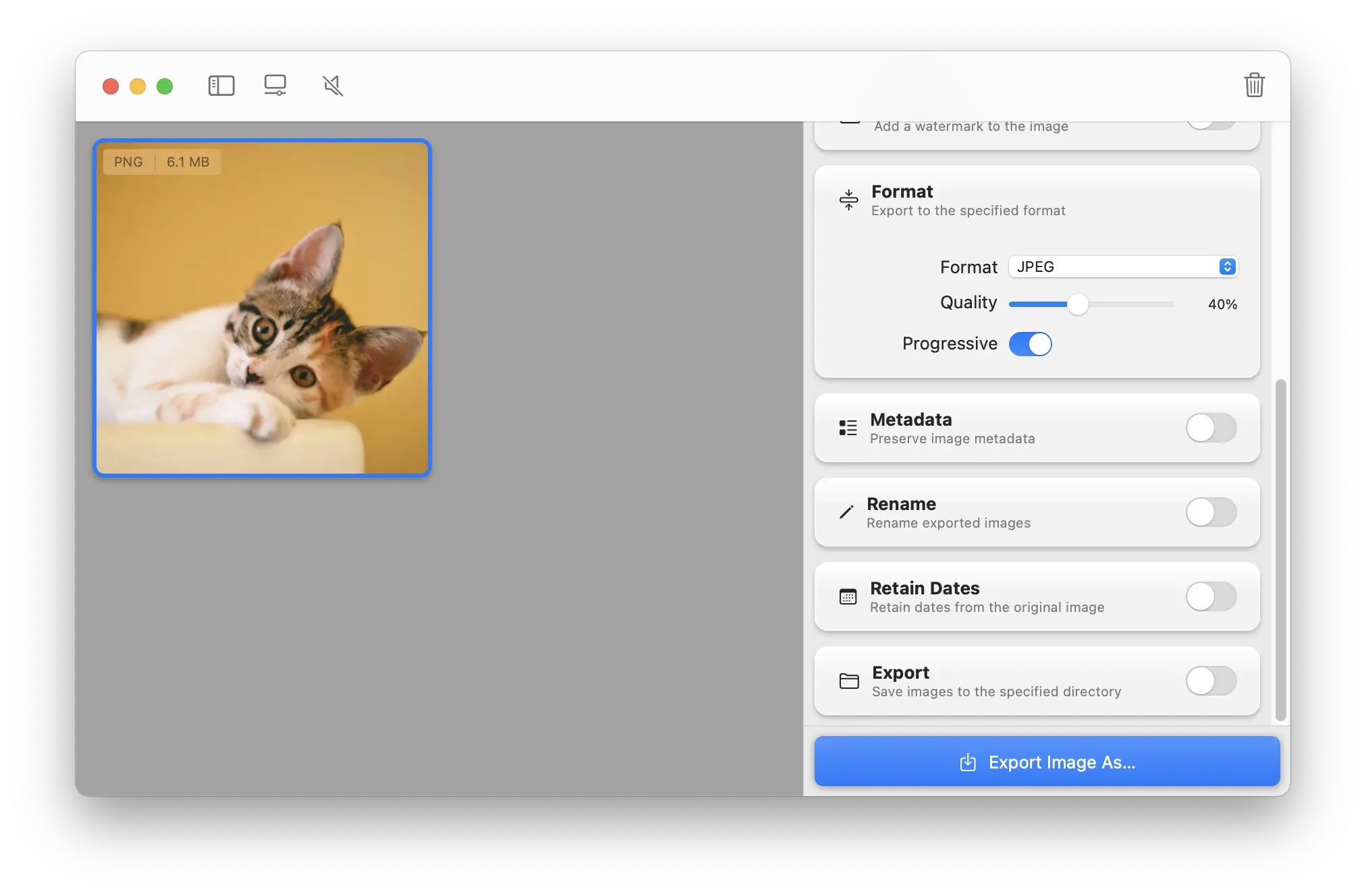
A case for a PNG file: Why you should use it
Compared to its popular rival JPEG, PNG is much more superior in terms of image quality it caters for. Thanks to lossless compression and transparency support, you can use PNG to create graphics for websites, edit and re-save screenshots as many times as you like, without sacrificing image quality.
In this table, I compare some of the most popular image formats — including those that support transparency — to give you a bit more context about the file types out there.
| Feature / Format | PNG | JPEG | WebP | AVIF | HEIF | SVG |
| Compression type | Lossless | Lossy | Lossy / Lossless | Lossy / Lossless | Lossy / Lossless | Vector |
| Transparency support | Full (Alpha) | ✗ | Full (Alpha) | ✓ Full (Alpha) | ✓ Partial | ✓ (via shapes/ opacity) |
| Animation support | ✗ | ✗ | ✓ | ✓ | ✓ (limited) | ✓ (via CSS/SVG animation) |
| Typical file size | Large | Small | Smaller than JPEG/PNG | Smallest | Very small | Very small (scalable) |
| Color depth | 24-bit + 8-bit alpha | 24-bit | Up to 24-bit + Alpha | Up to 12-bit/channel + Alpha | Up to 16-bit/channel | Device/ Renderer dependent |
| Best for | Graphics, UI, screenshots, transparency | Photos, web images | Web graphics & photos | Modern web & mobile photos | Mobile photos (Apple, HEIC) | Logos, icons, scalable graphics |
| Scalability | ✗ Raster image | ✗ Raster | ✗ Raster | ✗ Raster | ✗ Raster | ✓ Infinite |
| Metadata support (EXIF, ICC) | ✓ | ✓ | ✓ | ✓ | ✓ | ✓ (limited) |
Size-wise, PNGs may not seem so lucrative — they are heavier than JPEGs. But it’s easy to solve if you have Setapp tools like Squash, CleanShot X, and Permute on your Mac. Particularly if you like to save screenshots in PNG (and you should!) CleanShot X is undeniably the solution. It saves screenshots to the internal secure cloud so you don’t have to worry about gigabyte waste. Setapp is free to try with all the apps we’ve mentioned above for 7 days.
FAQ
Can you open PNG files on Mac?
You can open PNG files on Mac using the native Preview app. Simply double-click the PNG file or right-click the image and choose Open With > Preview to view it.
Does Apple support PNG files?
All macOS versions support PNG files and can be opened in almost every built-in image editing program. iOS devices also support PNG files, which can be opened in Photos or Files.
How do I make a PNG file on a MacBook?
Open the file you want to convert using the Preview app. Then, go to File > Export. In the dialog, choose PNG from the Format drop-down menu and click Save to create your PNG file.
How to download PNG on Mac?
Right-click the image and choose Save Image As, then choose the desired save location and click Save.

